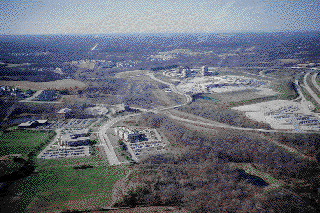
The aim of this project is to use the emerging edge city of Owings Mills in Baltimore County, MD as the focus of a study of urban design in the suburban context, and in particular, the reconsideration of the urban form of the edge city. Edge cities are the latest evolution of the dispersal and decentralization of American urban form into multiple centers of retail, office and residential developments centered on highway interchanges surrounding an older central city. Perhaps the best example of the edge city in the Virginia area is Tyson's Corner, outside of Washington, D.C.
Owings Mills, because of its peculiar conditions of transportation, development and ecology has the potential to serve as a positive example of what the developing urban entity of the edge city could be. It is equally poised, however, to become yet another example of the placeless wasteland of isolated buildings, parking lots and despoiled waterways that is rapidly becoming the normal condition of the American landscape. A particular focus of this study will be the development of design proposals that address the growing realization that natural systems and urban infrastructural systems need to be seen as a whole continuum that must be treated in a complete and coherent manner.
Owings Mills contains a unique set of circumstances that make it potentially valuable as a model of the "sustainable city". In one relatively concentrated area it contains all the necessary functions of a viable city: industry, commerce, residences and a highly developed transportation and water infrastructure, including mass transit, all directly adjacent to a complex and fragile aquatic ecosystem. What is missing is a model whereby all these attributes can be coherently organized into a city that is designed for pedestrians as much as it is for automobiles and as sensitive to the needs of natural systems as it is to those of people. The goal is to produce specific design solutions that integrate urban and natural systems into a habitable and public landscape.
Course Objectives:
Develop an understanding of the relationship between planning issues that may be seen as more general and abstract, and the specific spatial and formal results of planning decisions. The project will require the consideration of a variety of concerns such as transportation, landuse, politics, economics, environmental issues, etc. in, perhaps, a more comprehensive manner than has been required in previous studios, but will nevertheless continue to focus on the site-specific implications of those studies. The major difference in this case is that the study area is an entire community (or at least a large portion of it).
Understand the historic development of American urban patterns and attitudes towards urban design and planning and the prospects for the future. This will require the consideration of what are perceived to be the attributes American most desire in the communities within which they reside.
Consider the design and planning implications of new ideas of "sustainable" urban design and development.
Study site planning and urban design issues related to housing and residential areas and their relationship to public open space.
Explore the symbolic aspects of public spaces, and the interrelationship between symbol, utility and function.
Course Structure:
Although Owings Mills will be the one study area for the entire semester and the ultimate project will be the development of an integrated master plan for the town center of the community, there will be an introductory project on a portion of the site and then several different phases to the main project. As an introduction to the site and the existing community we will apply a different program, the cemetery, to a key undeveloped portion of the study area.
This course will also explore the state of collaborative design practice through the use of an on-site design charrette and networked computer information systems. We will convene an on-site design charrette and then continuing the collaborative process through networked design consultations conducted through the World Wide Web and the Internet.
 IATH WWW Server
IATH WWW Server